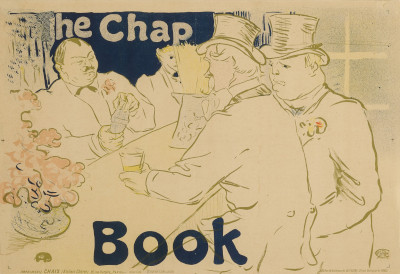Irish and American Bar, rue Royale - The Chap Book was designed by Henri de Toulouse-Lautrec in 1895. Several states of this design were published, with lettering appearing in later versions.
We find here in front of us a charming scene in which barman attends to two gentlemen. They appear to be in conversation, with one sat at the bar whilst another chooses to stand. The attire is smart and formal, entirely typical of how one might dress for a night out at the theatre during late 19th century France. Toulouse-Lautrec captured scenes from this type of environment many times over a period of several years and was a big fan of such events himself. He would relax in bars and theatres, becoming friends with performers and other patrons. Irish and American Bar, rue Royale - The Chap Book is one of the most famous prints which were produced from his designs, with several hundred copies being produced in a number of limited edition series. Each state would be different, either with a variation in colour or with lettering added, but the fundamental design would remain the same. The artist was highly skilled in figurative art and practiced his craft in small sketchbooks over a period of several decades, with this artwork helping to show Toulouse-Lautrec at the peak of his powers.
In the later states, the artist chose to fill the back wall in with colour, and then add the words "The Chap" over the top. He then reversed this colour and used it as lettering at the bottom of the work for "Book". This placement of text allowed the main three figures to remain untouched. He also sometimes coloured the flowers to the left hand side which sit in a pot on the bar. He would always keep the clear outlines of his work on display and these were very much a part of his illustrative style which would later influence modern day graphic design techniques. He was innovative in many ways, both in the style of his art, but also in the techniques the he used to produce prints. As his posters spread around Paris, many more businesses would ask for his services and he continued to make a steady income from advertisement posters such as this, all of which he could create fairly quickly because of the way in which he worked with clear lines and minimal detail.
In 2021, one of the lithographic prints which remains from these series was sold at Sotheby's, London for £18,900. This underlines how interest in this artist remains exceptionally high and French art in general from the late 19th century retains a high level of respect from collectors across Europe and also into the US as well. Another print can be found in the Chicago Art Institute, with the remainders either lost, destroyed or within private collections. The design made its way into several catalogue raisonnes which have added a level of authenticity to this piece and the overall nature of the content, and where it was set, feels entirely typical of the artist during the 1890s.




